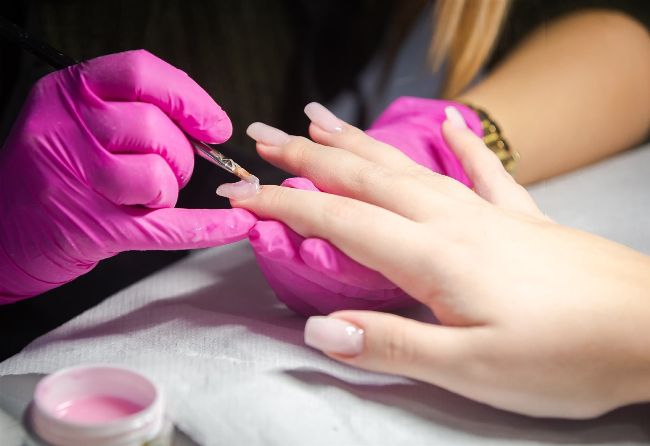The builder gel how to
For those clients who want strong, natural nails but don’t want to go the acrylic route, builder gel offers an attractive proposition

Image from Shutterstock
In terms of definitions, builder gel is a type of gel polish with a thicker consistency to help strengthen the natural nails. “Builder gel is a hard gel overlay,” explains nail tech Bryony Howell, aka GelsByBry.
Hadis Saleh, beauty therapist at Rawr, adds: “Using a builder gel is great for clients who are prone to nail breakage or nail biters. Available in a range of colours, it has a thicker consistency, and is designed to suit all whilst promoting natural growth.”
The product can be used to tackle a number of nail concerns, Grace Ricketts, owner of Birmingham salon OK Cure Me, explains.
“We have many clients with all different types of nails ranging from nail biters, brittle nails, ridges and soft nails. Using a good quality professional builder gel provides clients with a strong protective overlay,which allows nails to grow.”
"BUILDER GEL
comes in diverse
NATUR AL COLOUR R ANGES,
as well lots of
NUDE TONES.
It makes the
PERFECT BASE
for a
FRENCH
MANICURE."
For those who love a longer nail, Shian Paul, founder of Shian Nails, notes that “builder gel can also be used to create length as an extension on the natural nail, thanks to the thickness of the product”.
Builder gel comes in diverse natural colour ranges, as well lots of nude tones. It makes the perfect base for a French manicure.
How does application differ to regular gel?
While the process is similar in terms of curing, the thickness of builder gel means it can’t be applied the same way as regular gel, as any inconsistencies on the nail are more obvious.
“This thicker formula allows time for you to apply the builder gel and pull it into place, creating a smoother finish,” explains Ricketts.
“When applying builder gel, you are using this gel to sculpt a nail, create an apex or smooth out any imperfection of the nail,” adds Paul. “Then you refine the builder gel application by using a file or buffer; this will ensure you create a perfectly even and smooth builder gel manicure.”
Are there any drawbacks to builder gel?
Due to the nature of the application process and the thickness of the gel used, applying and soaking off builder gel can be more time-consuming than with normal gel, because it can take longer to cure or break down when soaking off.
Howell points out that soaking off the products isn’t the only option, as “[builder gel can] also be infilled which is less time-consuming”.
Infills can extend treatment time as the nail tech works to prep the nail, but Ricketts adjusts her pricing to reflect this.
“An infill again takes longer than a gel polish removal but time, along with other things, are considered when pricing out treatments and clients are made aware of the longer appointment times.”
Can clients develop allergies to builder gel?
With conversations around clients developing allergies to builder gel becoming hot topics on TikTok and in nail tech forums, it raises questions about the safety of using builder gels.
Paul explains how these allergies can develop, sharing that, “allergies can come from the use of any product, both builder gel and regular gel polish.
“Sensitivity to gel can happen in the application process if it is not applied correctly and it touches the skin surrounding the nail, also if you are not using the correct lamp to cure the product.”
HEMA, acrylates, methacrylate and solvents such as acetone or dyes are ingredients commonly found in gel polish and builder gel that can sometimes cause allergies. It’s always a good idea to check with any new clients to see if they have reactions to gel polish before to help inform which products you use with them.
For Ricketts, nail health checks are key to keeping an eye on any abnormal reactions. “A client can become allergic to anything at any point – but there are triggers.”

Image from Shutterstock
"ALLOW
the
GEL TO SETTLE
before
CURING IN THE LAMP.
Builder gel is generally
SELF-LEVELLING,
so allowing it to settle and
TURNING THE HAND UPSIDE
DOWN
for a few seconds
ENSURES THIS PROCESS
is carried out"
As a salon owner, it’s paramount that staff observe their clients’ nail health to eliminate risks of a reaction. Says Ricketss: “We infill every two to three weeks and do a full removal after their second infill and restart with new overlays. If we haven’t seen a client for a really long time, we do a full removal and a nail health check.”
For Saleh, nail prep also plays a big part, as she shares, “Correct nail prep is of extreme importance when applying any nail enhancement.
“The nail plate and cuticles must be correctly prepared prior to application to avoid any product lifting. When a product lifts it can cause product and bacteria to become trapped between the enhancement and the nail plate which may cause an adverse reaction.”
Top tips for working with builder gel
Hadis Saleh: “Allow the gel to settle before curing in the lamp. Builder gel is generally self-levelling, so allowing it to settle and turning the hand upside down for a few seconds ensures this process is carried out to ensure a smooth and even finish.”
Bryony Howell: “My number one tip for working with builder gel would be to work with one nail at a time and cure in between nails. This ensures flawless application and saves time (so you don’t have to refine after application).”
Shian Paul: “Practice makes perfect. As with anything, the more you do a builder gel manicure, the more you can perfect your skill.”
Grace Ricketts: “Can I say two? Regular nail health checks and use a fine brush to push and pull the builder gel into place.” (Source: Professional Beauty UK)